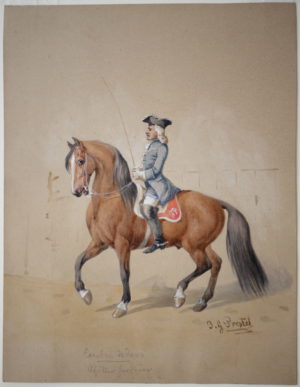Prestel, Johann Erdmann Gottlieb, the Younger (1804-1885)
Johann Erdmann Gottlieb Prestel was a German painter and sculptor and is best known for his animal portraits.
The father, Johann Adam Prestel , fourth son of Johann Gotllieb Prestel and Maria Katharina Prestel, was himself a portrait painter and engraver in Frankfurt and in 1800 married Dorothea Christ, the daughter of the mayor of Sachsenhausen. After both parents died young, Johann Erdmann Gottlieb Prestel was placed in the care of an uncle who gave him his first horse when he was 11 years old. Horses were his biggest passion next to art from a young age. Original plans to work at the Frankfurt Riding School were later shelved in favour of his talent for drawing, which was becoming increasingly evident. As a young man, he himself began to teach drawing to his peers at night school.
In 1822 he went to Munich, where he aimed for more specific training as a painter. In Munich he was accepted at the Academy of Fine Arts, but also attended courses in anatomy and veterinary medicine. There he also made acquaintance with the artistic greats of his time such as Wilhelm von Kaulbach, Moritz von Schwind, Heinrich Heinlein, Dietrich Monten, Friedrich Foltz, the Zimmermann brothers and Professor Haushofer.
After completing his studies, he moved to Vienna, where landscape and animal painting played an important role at court and in aristocratic circles. Here Prestel, through his horsemanship, character and talent for painting, won the favour and friendship of important aristocrats, such as that of Count Festetics or Napoleon’s son, Napoleon Franz Bonaparte. He also maintained a friendship with the Vienna-based poets of his day, including Nikolaus Lenau and Anastasius Grün. A little later he was also drawn to Hungary because of the contacts he had made in Vienna, where he became director of a stud farm, among other things. He studied and painted the wild horses of the Hungarian Pusta, as well as deer and wild boar hunting. His acquaintance and lifelong friendship with Count Moritz Sándor von Slavnica, the son of one of the richest Hungarian magnate families, was important for his career and made him well-known in aristocratic circles.
In the early 1830s, Prestel was drawn to Italy to study painting further, traveling there with Carl Robert Kummer, who later became director of the Dresden Academy of Arts. His riding horse on this journey, a magnificent Arabian stallion, would later become the model for the horse in the equestrian statue of Maximilian I in Munich. In Rome, Prestel made friends with the later Pope Leo XIII , who was then serving as an officer. The pictures of a dying stag and a neighing stallion brought him great prestige and numerous follow-up commissions. Among other things, he was assigned the plastic execution of the horses on the first of the designed Wallhalla friezes. Both this and the draft for Thorvaldsen ‘s equestrian statue commissioned by King Ludwig I was taken over by young Prestel without asking for a fee. Shortly thereafter he worked for Wilhelm I of Württemberg and had to turn down a collaboration with Horace Vernet . Prestel stayed in Rome for the most part for eight years and became acquainted with Ludwig Schwanthaler and Gottfried Semper, with whom he later maintained a lively exchange.
After traveling through southern Italy, Sicily, Greece, and Egypt, he returned to Hungary in 1838, where he met again Sándor, who had also visited him in Italy. With Sándor, Prestel undertook a journey through Germany, where the two paid a visit to Goethe in Weimar. From Germany the journey continued to Paris, London, and Scotland, where they visited Edwin Landseer.
In 1839, Prestel accepted a call from the Duke of Nassau and became court painter at the Biebrich court for life. He even preferred this job to an offer from the Emperor in St. Petersburg. The political unrest in the run-up to the revolution of 1848 led to Prestel’s dismissal from his position and his move to Mainz. Already in 1841, he had married Anna Britz, the daughter of the Kurmainz family Barth. Both had at least three children Caroline Catherine Prestel (* July 19, 1843), Jakob Prestel (* 1847 – † 1930), Elise Dorothea Leonore Therese Prestel (* February 27, 1856 in Mainz – † July 1, 1921 in Mainz).
During the years of upheaval, Prestel spent more time in the Bavarian part of the Alps, where he sketched animals while mountaineering and accompanied the king on hunts. In 1849 he accepted a call from Emperor Franz Joseph to Vienna. In addition to numerous horse and game paintings, sculptural works were also created in Vienna, such as the tympanum field of the hunting lodge in Ischl, as well as medallions for the Imperial Riding School and other handicraft objects. The Kaiser later offered Prestel positions as professor at the art academy or first inspector of the state studs around 1859, all which Prestel declined to return to his family in Mainz in the early 1860s, which he had previously only been able to do in winter. There he was later visited by the emperor during a private audience when he was in Frankfurt for the Congress of Princes in 1863.
He remained active as an animal painter until his sudden death in 1885.
Showing the single result
